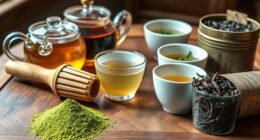Making turmeric tea at home is something I absolutely love. It’s not just tasty; it also offers plenty of health advantages, making it an excellent choice for any meal plan. In this article, I’m going to show you how to craft your own turmeric tea right from the beginning.
Firstly, let’s take a look at some of the benefits of drinking turmeric tea. Turmeric contains curcumin, which has anti-inflammatory properties and may help reduce joint pain and inflammation in the body. It also has antioxidant properties that can help protect against damage caused by free radicals in the body. Additionally, studies have shown that turmeric may improve brain function and lower the risk of heart disease.

With all these benefits in mind, let’s get started on making our own homemade turmeric tea!
Key Takeaways
- Turmeric tea has numerous health benefits, including reducing inflammation, improving brain function, and aiding digestion.
- Making turmeric tea requires a few key ingredients, including turmeric powder, water, and optional add-ins like honey or ginger.
- Precautions should be taken when consuming turmeric tea, as high doses can cause negative side effects and interact with certain medications.
- Turmeric can be used in a variety of ways, including as a face mask for skin and to alleviate sore throat when mixed with ginger and honey.
Benefits of Turmeric Tea
Turmeric tea has many benefits, including reducing inflammation, improving brain function, and potentially lowering the risk of chronic diseases like cancer and Alzheimer’s. Research shows that turmeric has curcumin, a powerful antioxidant with anti-inflammatory properties. This makes it an excellent natural remedy for managing joint pain, swelling, and other inflammatory conditions.
Moreover, turmeric tea can boost brain function by increasing levels of a hormone called Brain-Derived Neurotrophic Factor (BDNF), essential for the growth and survival of neurons in the brain. Studies have found that long-term consumption of turmeric tea may improve memory, attention span, and overall cognitive function.
If you’re looking to incorporate turmeric into your daily routine, making your own turmeric tea is an easy way to do so. But let’s first take a look at the ingredients you’ll need.
Required Ingredients
To make my own turmeric tea, I’ll need a few key ingredients. First and foremost is turmeric powder, which can be easily found at most grocery stores.
Next, I’ll need water to brew the tea.
Finally, I have the option to add in some honey or ginger for a touch of sweetness and added health benefits.
With these simple ingredients, I can create a delicious and nutritious cup of turmeric tea right at home.
Turmeric Powder
With a pinch of this bright yellow spice, you can add a burst of sunshine to your morning routine. Turmeric powder is one of the main ingredients needed to make a delicious cup of turmeric tea. Not only does it give the tea its distinct flavor and color, but it also provides numerous health benefits.
Here are four reasons why adding turmeric powder to your diet is a great idea:
- Anti-inflammatory properties: Turmeric has been used for centuries in traditional medicine due to its anti-inflammatory properties. This makes it an excellent ingredient for managing conditions such as arthritis and other chronic inflammatory diseases.
- Boosts immunity: Curcumin, the active compound found in turmeric, has antioxidant and antibacterial properties that help boost the immune system’s function.
- Aids digestion: Drinking turmeric tea can help with digestion issues by reducing inflammation in the gut and improving overall digestive health.
- Versatile ingredient: Turmeric powder can be used in various recipes, making it easy to incorporate into your diet regularly.
Now that we know about the many benefits of turmeric, let’s move on to the next step – water!
Water
Staying hydrated is essential for maintaining overall health and wellness, so let’s dive into why water is so important when making turmeric tea. Water is a key ingredient in any tea, but especially when it comes to making turmeric tea.
There are two methods to make this tea: boiling method and infusion method, both of which require water as the base. The boiling method involves adding turmeric powder to boiling water and letting it simmer for 10-15 minutes. This allows the water to fully extract the active compounds in the turmeric powder, resulting in a stronger flavor and more potent health benefits.
On the other hand, the infusion method involves steeping fresh or dried turmeric root in hot (but not boiling) water for several minutes until desired strength is achieved. Whichever method you choose, be sure to use clean filtered water for best results.
Now that we’ve covered the importance of water in making turmeric tea, let’s move on to optional add-ins like honey and ginger for added flavor and health benefits.
Optional Add-ins (Honey, Ginger)
Adding a touch of honey or a slice of ginger to your turmeric brew is like putting the cherry on top of an already delicious sundae. Not only do these add-ins enhance the flavor, but they also bring additional health benefits to your tea.
Honey has natural antibacterial properties and can help soothe sore throats and coughs. It also contains antioxidants and can aid in digestion. When choosing honey for your turmeric tea, opt for raw honey as it retains more nutrients compared to processed ones.
As for ginger, there are endless recipes you can try with this versatile root – from pickled ginger to stir-fries. When added to turmeric tea, it provides an extra layer of warmth and spice while promoting anti-inflammatory effects in the body.
To continue making your own turmeric tea, you’ll need some equipment that’s easily accessible in most kitchens.
Equipment Needed
You’ll need a small saucepan, strainer, and teaspoon for this turmeric tea recipe. Additionally, having the right equipment can make the process easier and more enjoyable.
Here are some other items that you may find helpful:
- Tea Infusers: If you prefer loose leaf tea to tea bags, a tea infuser is an essential tool to have on hand. It allows you to steep your turmeric tea without worrying about loose bits floating around in your cup.
- Tea Kettles: While not necessary, many people find that using a dedicated kettle for their tea helps them achieve consistent results. Electric kettles are especially useful because they allow you to heat water quickly and precisely.
- Brewing Techniques: There are several ways to brew turmeric tea, including simmering it on the stove or steeping it in hot water like traditional tea. Experiment with different methods until you find one that works best for your taste preferences.
- Flavor Enhancements: While turmeric has a pleasant flavor on its own, adding other ingredients can help enhance its taste and health benefits. Consider adding honey or ginger to your turmeric tea for added sweetness and anti-inflammatory properties.
Now that we’ve covered the equipment needed for making turmeric tea, let’s move onto the steps involved in making this delicious beverage at home!
Steps to Make Turmeric Tea
First, imagine holding a warm mug in your hands as the aromatic scent of spices wafts up to your nose and fills you with a sense of comfort and relaxation. Making turmeric tea is simple, and all you need are a few basic ingredients.
Start by boiling water in a saucepan or kettle. While the water is heating up, gather some fresh turmeric root or ground turmeric, ginger root (fresh or powdered), honey (optional), and lemon juice.
Once the water has come to a boil, add about 1 teaspoon of grated fresh turmeric root or ½ teaspoon of ground turmeric to the pot. If using fresh ginger root, peel and grate it into the pot as well. Let these ingredients simmer for about 5-10 minutes on low heat. This will allow the flavors to infuse into the water properly.
Strain out any remaining bits of spice from your mixture and pour it into your favorite mug. Add honey or lemon juice if desired for added flavor. You can also experiment with different combinations such as adding cinnamon sticks or black pepper to enhance its health benefits even further!
With this simple recipe, you can avoid buying expensive turmeric supplements or indulging in sugar-laden turmeric latte recipes at coffee shops.
In conclusion, making your own cup of deliciously healthy turmeric tea couldn’t be easier! Not only does it taste great but it’s packed full of anti-inflammatory properties that make it an excellent addition to any diet. Stay tuned for some tips on how to make that perfect cup next!
Tips for Making the Perfect Cup of Turmeric Tea
When making turmeric tea, there are a few key things to keep in mind to ensure the perfect cup. First and foremost, the ratio of ingredients is crucial. Too much or too little turmeric can drastically affect both the taste and health benefits.
The simmering time also plays a role in both taste and potency. Overcooking can lead to a bitter flavor and potential loss of nutrients.
Lastly, choosing the right straining method can help remove any leftover sediment or particles for a smooth and enjoyable drinking experience.
Ratio of Ingredients
To make a delicious turmeric tea, all you need is a tablespoon of grated or ground turmeric and two cups of water. However, if you want to experiment with alternative ingredients or flavor variations, feel free to add honey, ginger, lemon juice, or even cinnamon. These ingredients not only enhance the taste but also boost the medicinal properties of the tea.
The ratio of ingredients is crucial in making the perfect cup of turmeric tea. Too much turmeric can overpower the other flavors, while too little can result in a bland taste. So, be sure to stick to the recommended measurement for optimum results.
Once your ingredients are ready, it’s time to move on to simmering time!
Simmering Time
Simply simmering for a short spell will help extract all the essential components from the ingredients, resulting in a splendidly spiced sip.
When it comes to simmering turmeric tea, you can either use a stove-top or an electric kettle. If using a stove-top, add water and turmeric powder to a saucepan and bring it to boil over medium heat. Once it starts boiling, reduce the heat and let it simmer for 10-15 minutes.
During this time, you may add other spices like ginger or cinnamon depending on your flavor profile. Simmering techniques vary based on personal preference, but be sure not to overcook the tea as it can result in a bitter taste.
After 10-15 minutes of simmering, turn off the heat and let the mixture cool down before straining. Speaking of which, let’s move onto our next section about straining method that’ll give us that perfect cup of turmeric tea!
Straining Method
For the perfect cup of turmeric tea, you’ll want to strain the mixture using a fine mesh sieve or cheesecloth.
Once your tea has simmered for about 10 minutes, it’s ready to be strained and enjoyed.
The straining process helps remove any remaining chunks or residue from the ginger and turmeric root, resulting in a smoother texture.
When straining your tea, it’s important to use proper techniques to ensure that you get the most out of your brew.
Be sure not to press down too hard on the solids when using a cheesecloth as this can cause unwanted particles to seep through.
Instead, allow gravity to do its job and let the liquid pass through naturally.
With these simple straining techniques and brewing time guidelines, you’ll be able to enjoy a perfectly brewed cup of turmeric tea in no time!
Now let’s move on to exploring some variations of this delicious beverage.
Variations of Turmeric Tea
You’ll be surprised at the endless possibilities of turmeric tea variations. Aside from the classic recipe, there are many other ways to enjoy the benefits of this spice in your drink. Here are some ideas:
- Turmeric latte: Similar to a regular latte, this version includes frothy milk and a shot of espresso combined with turmeric powder for an energizing morning drink.
- Turmeric smoothie: Blend frozen fruits like mango or pineapple with coconut milk, ginger root, and a teaspoon of turmeric for a refreshing summer beverage.
- Golden milk: A traditional Indian recipe that mixes turmeric with warm milk and honey for a soothing drink before bedtime.
- Iced turmeric tea: Brew fresh mint leaves and black tea in boiling water, then add grated turmeric root and refrigerate until cold. Serve over ice with lemon slices.
By exploring these different approaches to making turmeric tea, you can find new flavors that suit your taste buds while also reaping the health benefits.
However, it’s important to remember that while turmeric is generally safe for consumption in moderate amounts, excessive intake may cause stomach issues or interact negatively with certain medications. Always consult with your doctor or healthcare professional before introducing any new supplements or herbs into your diet.
Health Precautions
As I’m exploring the health benefits of turmeric tea, it’s important to also discuss potential side effects and interactions with medications.
While turmeric is generally safe for most people, some may experience side effects such as stomach upset or allergic reactions. Additionally, turmeric may interact with certain medications such as blood thinners or diabetes medications.
It’s important to follow recommended dosages and consult with a healthcare provider before incorporating turmeric tea into your diet.
Potential Side Effects
To avoid any potential side effects, it’s important to consult with your healthcare provider before incorporating turmeric tea into your daily routine. While turmeric is generally safe for consumption, some people may experience side effects such as nausea, diarrhea, and stomach upset. These side effects are usually mild and go away on their own after a few days.
It’s also important to note that high doses of turmeric can cause more serious side effects such as liver damage or an increased risk of bleeding. If you have a history of liver disease or take blood-thinning medications, it’s especially important to speak with your doctor before drinking turmeric tea regularly.
With the right precautions in place, however, most people should be able to enjoy the many health benefits of this delicious and nutritious beverage without any issues.
As we move onto the next section about interactions with medications, it’s essential to keep in mind that some drugs may interact with turmeric and lead to unwanted complications.
Interactions with Medications
It’s crucial to be aware of potential interactions between medications and turmeric, as some drugs may have unwanted complications when taken with the herb.
Turmeric can increase the effects of blood thinners such as warfarin, increasing the risk of bleeding. This is because turmeric also has anticoagulant properties that can cause blood thinning.
Additionally, turmeric may interact with medication used to treat diabetes by lowering blood sugar levels too much. It’s important for individuals taking medication for diabetes to closely monitor their blood sugar levels and consult with their healthcare provider before adding turmeric to their diet as a supplement or in tea form.
With this in mind, it’s always recommended to speak with a healthcare provider before incorporating any new herbs or supplements into your daily routine, especially if you’re taking prescription medications or have underlying health conditions.
Moving forward into the subsequent section about recommended dosage, it’s important to note that while turmeric has many potential health benefits, it’s still important to use it in moderation and according to recommended dosages.
Recommended Dosage
Using turmeric in moderation and following recommended dosages is crucial for ensuring its potential health benefits without any adverse effects. When it comes to making turmeric tea, it is important to note that the recommended daily dosage of curcumin (the active ingredient in turmeric) is between 500-2000 mg. This can be achieved by incorporating 1-2 teaspoons of ground turmeric powder into hot water or milk.
In addition to potentially aiding weight loss and improving skin health, regularly consuming a moderate amount of turmeric may also have anti-inflammatory and antioxidant properties. However, it is important to consult with a healthcare professional before adding any new supplement or herb into your diet, especially if you are taking any medications or have pre-existing medical conditions.
| Turmeric Tea | Benefits | Potential Risks |
|---|---|---|
| May aid weight loss | High doses may cause gastrointestinal issues such as nausea and diarrhea | |
| May improve skin health | Can interact with certain medications such as blood thinners |
Moving on to other uses for turmeric…
Other Uses for Turmeric
Turmeric not only adds flavor to dishes, but it also has various health benefits and can be used for skincare. Here are some other uses for turmeric that you may find helpful:
-
Turmeric has anti-inflammatory properties that can help reduce acne and improve skin texture. You can use it as a face mask by mixing turmeric powder with honey or yogurt. Apply the mixture to your face and leave it on for 10-15 minutes before rinsing off.
-
Aside from adding flavor, turmeric contains curcumin, which is a natural anti-inflammatory compound. This makes it great for reducing inflammation in the body, which is linked to many chronic diseases like heart disease and cancer. Try using turmeric in soups, stews, or even smoothies.
-
In addition to its anti-inflammatory properties, turmeric has been found to have antioxidant effects as well. Antioxidants protect our cells from damage caused by free radicals, which can lead to aging and disease. Studies have shown that curcumin in turmeric may also boost brain function and reduce the risk of Alzheimer’s disease.
-
Lastly, if you’re feeling under the weather or have a sore throat, try making a warm cup of turmeric tea with ginger and honey. Not only will it taste delicious but it may also help alleviate symptoms due to its antibacterial properties.
Overall, incorporating more turmeric into your daily routine can provide numerous health benefits both internally and externally through skincare practices. Be sure to talk with your healthcare provider before starting any new supplement regimen or topical application of this spice!
Frequently Asked Questions
How long does turmeric tea stay fresh after making it?
Regarding turmeric tea storage, it’s important to know its shelf life and expiration date in order to maintain its freshness and preserve quality. To ensure that the flavor stays intact, it’s recommended to store turmeric tea in a cool and dry place, away from direct sunlight or heat sources.
Tea storage tips include using airtight containers made of glass or ceramic, which prevent moisture from seeping in. Following tea storage guidelines can help extend the shelf life of turmeric tea and keep it fresh for up to 2-3 days after making it.
However, if you want to enjoy a cup of hot turmeric tea beyond this time frame, simply reheat it on low heat until warm and add a dash of honey or lemon juice for extra flavor.
Can I add honey or other sweeteners to my turmeric tea?
Yes, you can definitely add honey or other sweeteners to your turmeric tea! While turmeric has a slightly bitter taste on its own, adding a natural sweetener like honey or agave can help balance the flavor and make it more enjoyable. If you prefer not to use honey, some other popular alternatives include maple syrup, coconut sugar, and stevia.
When it comes to the best time to drink turmeric tea, many people find that sipping on a warm cup before bed can promote relaxation and improve sleep quality. Others prefer to enjoy it in the morning as a caffeine-free alternative to coffee. Ultimately, there’s no right or wrong time – it all depends on your personal preference and individual needs.
Is it safe to drink turmeric tea every day?
Drinking turmeric tea every day is generally safe and can offer numerous health benefits. Studies suggest that the active compound in turmeric, called curcumin, has anti-inflammatory and antioxidant properties that may help reduce the risk of chronic diseases such as cancer, Alzheimer’s disease, and heart disease.
However, it’s important to note that the dosage of curcumin in turmeric tea may vary depending on how it’s prepared. It’s recommended to consume no more than 1-2 teaspoons of ground turmeric per day or consult with a healthcare professional before incorporating it into your daily routine.
Overall, drinking turmeric tea in moderation can be a great addition to a healthy lifestyle.
Are there any known side effects of consuming turmeric tea?
Turmeric tea has gained a lot of popularity in recent times due to its numerous health benefits. However, it’s important to note that there are some risks and precautions associated with consuming turmeric tea.
Some people may experience gastrointestinal side effects such as nausea, vomiting, and diarrhea when they consume large amounts of turmeric tea. Additionally, individuals who have gallbladder problems or are on blood-thinning medications should exercise caution when drinking turmeric tea as it may interact with their medication.
It’s also important to note that while turmeric has anti-inflammatory properties, it shouldn’t be used as a replacement for medical treatment. Overall, turmeric tea can be a healthy addition to your diet, but it’s always best to consult with your healthcare provider before incorporating it into your routine.
Can I use powdered turmeric instead of fresh turmeric root to make my tea?
Yes, you can use powdered turmeric as a substitute for fresh turmeric root when making turmeric tea. However, it’s important to note that the benefits of using fresh turmeric root are greater than those found in powdered turmeric. Fresh turmeric contains higher levels of curcumin, which has anti-inflammatory properties and promotes brain function. Additionally, the flavor profile of fresh turmeric is more complex and nuanced compared to its powdered counterpart.
That being said, if fresh turmeric root isn’t readily available or convenient to use, powdered turmeric can still provide some health benefits and add flavor to your tea. Just make sure to store your powdered turmeric in an airtight container away from light and heat to preserve its potency.
Conclusion
Well, that’s it folks! You now know how to make your own turmeric tea. I hope you’ll find this information helpful and give the recipe a try soon.
Remember, turmeric tea is not only delicious but also beneficial for your health. It can help with inflammation, digestion, and immunity.
But wait, there’s more! Did you know that turmeric has been used for centuries in Ayurvedic medicine? It’s also a popular spice in Indian cuisine and can be found in many dishes, such as curries and rice pilafs.
So, go ahead and explore the many uses of turmeric beyond just making tea. Who knows what other benefits it may hold for you? Happy brewing!










